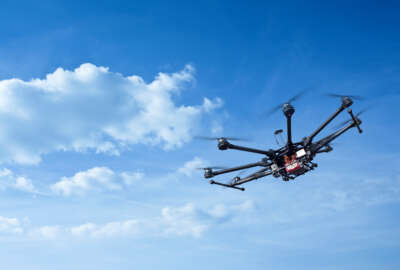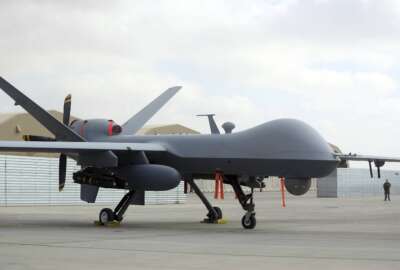From search and rescue to intelligence, surveillance and reconnaissance to inspecting towers, Customs and Border Protection is demonstrating how drones are more than just a fun hobby.
CBP is recognizing not only the time and cost savings, and more importantly the safety to officers that small, unmanned aircraft can provide.
Quinn Palmer, the National Operations Director for small unmanned aircraft systems at CBP in the Homeland Security Department, said the use of drones has evolved across the agency’s mission sets.
“Small drones are really filling a critical niche between fixed surveillance systems and crewed aviation or manned aviation assets because of their range, because of their price point and the quick deploy ability,” Palmer said on Ask the CIO. “They can offer us surveillance over a much larger area on the border, like for search and rescue where we can cover broad swaths of territory very quickly. But another interesting piece of that is the nature of the drone, meaning its covertness, that’s been a hugely impactful component to how why drones are so valuable to us and to our agents in the field. What I mean by that is having the ability to surveil a target or a law enforcement situation covertly or silently allows our folks that situational awareness, that critical time element, to prepare more smartly to position themselves to make that initial engagement, which lends itself to officer safety, but also to the effectiveness of the law enforcement resolution.”
This type of impact is true across many CBP mission sets. From border surveillance and related missions to facility and tower inspections to creating training videos, using drones, for internal communications, the agency is using these unmanned small aircraft systems in more ways than ever imagined.
CBP flew 100,000 sorties in 2023
To that end, Palmer said CBP has grown its drone pilot crew to about 2,000 strong operating more than 330 systems from just half a dozen systems and 20 operators a about five years ago. It plans to grow to more than 500 assets and continue to train and hire operators in 2024.
“The response by the field, by the folks that are out there on the front line, are really engaging in and advocating for this capability in this technology. The leadership now see the value too,” Palmer said. “It’s always a trade off when you’ve got a workforce that’s stretched amongst many competing requirements and commitments, adding one more thing to do is something we’ve got to be very conscious about. It can be a distraction. It can be a negative to the labor cost of conducting a border security mission. But drones have not been that. It’s been a labor saving capability. We see an effect at the ground level, but not just in the price tag but in the time it takes to resolve law enforcement situations.”
In 2023, CBP flew about 20% of all of the direct air support missions for ground agents of the border patrol. From those flights came 48% of all apprehensions and seizures, Palmer said.
“We’re putting out about 25% of the output, but yielding about 50% of the outcome. That’s due to the proliferation of more drones being more places than manned aviation, but also the nature of the drone being covert and the effectiveness it lends its self to that interdiction aspect,” he said. “We apprehended about 42,000 folks crossing the border illegally. In fiscal 2020 through 2023, about 2,800 pounds of narcotics were seized, 95 vehicles seized and 13 weapons seized. That resulted from about 100,000 sorties about 50,000 hours flown.”
Sustainment plans for drones
All of those efforts in using drones instead of manned aviation in 2023 resulted in about $50 million in cost avoidance. Palmer said that money can be put back into mission and operational priorities helping the agency extend its limited budget.
“We’re actually benefiting not just from the cost savings associated with deploying drones versus some of these other more expensive surveillance capabilities. But we’re also benefiting because we’re able to control that interdiction much more efficiently, which translates into savings on the ground level because the labor costs associated with and the time associated with accomplishing that interdiction, and that resolution is minimized,” he said. “In many different ways, we found that drones are impacting and it’s not just from the budgetary standpoint, but they’re impacting the tactical advantage in the field.”
As with any new technology, CBP is learning how to manage the drones and educating the industry.
For example, the agency runs drones in austere environments whether cold, heat, dust or precipitation in a way that many manufacturers didn’t intend the systems to run in.
“We are using our equipment a lot compared to some of the other drone users in the United States. We’ve had industry partners say we never intended to fly this this much. We’re like, ‘well, don’t sell it to us,” Palmer joked.
Palmer said this means having a strict sustainment plan is more important than ever to keep the drones flying.
“This gentlemen at the National Transportation Safety Board (NTSB) told me this, and I’ll share it with you because I was thought it was very relevant. Drones are engineered to do very sophisticated things. But they’re engineered also at the same level as the toaster on your kitchen counter. So we do very intricate and very sophisticated things with drones, but they are consumable, for lack of better term,” he said. “We do have for our higher costing assets have sustainment plans and lifecycle plans associated to those acquisitions We do our due to our hard work to make sure that that that battery rotation and those kits are tracked and the motor arms and the propellers are replaced per manufacturer specifications. We’re doing all those kinds of things on the ground. But ultimately, small drone is should be considered as a consumable. They’re just not built to sustain.”
At the same time, Palmer said the marketplace is moving so fast that CBP or any organization could move to the next generation fairly quickly and inexpensively outweighing the cost of long-term sustainment plans.
Copyright
© 2024 Federal News Network. All rights reserved. This website is not intended for users located within the European Economic Area.






